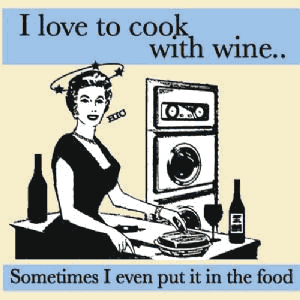"Wine is bottled poetry."
~Robert Louis Stevenson
When it comes to wine, I have a lot of opinions. Most of them involve "that's delicious," "give me more," and "a bottle counts as one."

It's been a party ever since, several millennia ago, someone noticed that some grapes had rotted so badly that they were good again.
There's so much good information out there about wine that it would be pointless for me to go on a long, very me-like diatribe about it.
If you're really interested, check out Jamie Goode's wine blog, or Sarah Ahmed's. Or pick up a copy of The Sommelier Prep Course, which is meant to prepare people to take the exams for the level one sommelier qualification. But, it turns out, if you're interested in wine it's a fascinating read and a fabulous resource for looking up just about anything boozy. (It's also not too expensive at a mere £23 from Amazon).
But wine, of course, is not just for drinking.
I remember, years ago, when I started getting into cooking (but before I knew anything about wine), having to Google a dry white wine to use in a recipe. And, back then, there wasn't anything out there that was easily accessible that would just frickin' tell me what to use!
And then, of course, I started to ask all kinds of other questions. Does quality matter? Can it come from a box instead of a bottle? What on earth does dry mean anyway?
I have three rules I generally adhere to when it comes to cooking with wine.
Extremely Important Maxim of Cooking With Wine #1: Don't cook with something you wouldn't drink.
Think about this logically: if you wouldn't drink it then why would you eat it?
That being said, every chef in every professional kitchen, from your mom and pop shop around the corner all the way up to the great Michelin-starred restaurants, are using boxed wine in their kitchens. It's true. I've worked in enough restaurants to know. Just get something good. (Living in the UK, I've come to miss my Bota Box... Truly, one of the US's greatest products.)
Which brings us to Extremely Important Maxim of Cooking With Wine #2: Good does not necessarily equal expensive; and expensive does not necessarily equal good.
Now, I'm no wine snob. Nor am I a sommelier. But I've been selling and serving the stuff--and curating wine lists in restaurants--for years, so I do know what I'm talking about.
Years ago, I was waiting tables in a lovely high-end restaurant. One of the guests left a glass of a really expensive cabernet behind for me to have after my shift (nice, right?!). Was it good? Absolutely. It had better be at $120 a bottle. But two days before I had shared a bottle of cabernet with some friends that cost $12. Surprise: the $12 bottle was much better.
Maybe there's a bit of personal taste involved there. But the wine market has become so varied and vintners have gotten so good that even a cheap bottle is probably of good enough quality to drink, and therefore to cook with.
Extremely Important Maxim of Cooking With Wine #3: Use wine that will complement your ingredients.
As a general rule, I usually go with:
Red Meat = Red Wine
White Meat = White Wine
Of course, this is not always the case. There are classics out there that flout this, like coq au vin, which is chicken in red wine. And then there's dessert/fortified wine, like sherry, that goes spectacularly with chorizo.
But if you're just throwing in some wine for a chicken dish, default to white.
There's a good reason most recipes and chefs default to this: chicken doesn't have a lot of flavour, and easily takes on whatever you're cooking it with. If you use a big, bold red with chicken then you're going to lose the essential chicken-ness in the dish to the flavour of the wine. Likewise with fish: while it has flavour, it's easily overwhelmed.
Now, you'll also note that most recipes call for a dry wine. When people describe a wine as dry, they mean it isn't sweet. A wine that gives you the physical sensation of dryness--you know, when you feel like you've got socks on your teeth--is called astringent.
Then there's the difference in body, which is how intense the wine is. You'll hear light-bodied, medium-bodied, and full-bodied all over the place. Think about it this way: if you'd find it refreshing and something to drink in the summer, then it's probably light-bodied. If it's what you'd drink in the depths of winter and has some punch to it, it's probably full-bodied.
(Body style is usually determined by alcohol content. For a neat discussion on this, check out Vine Pair.)
Vintners will make their wines a little differently, so this isn't necessarily always going to be 100% true, but the below works generally well:
WHITE WINE
Medium-bodied, dry
Pinot Grigio, Sauvignon Blanc
Full-bodied, dry
Chardonnay
RED WINE
Light-bodied, dry
Pinot Noir
Medium-bodied, dry
Merlot, Malbec, Primitivo
Full-bodied, dry
Cabernet Sauvignon, Zinfandel, Syrah/Shiraz
If you're looking for a dry wine, steer clear of riesling, moscato, fortified/dessert wines (e.g., port, sherry, vin santo, sauternes, etc.).